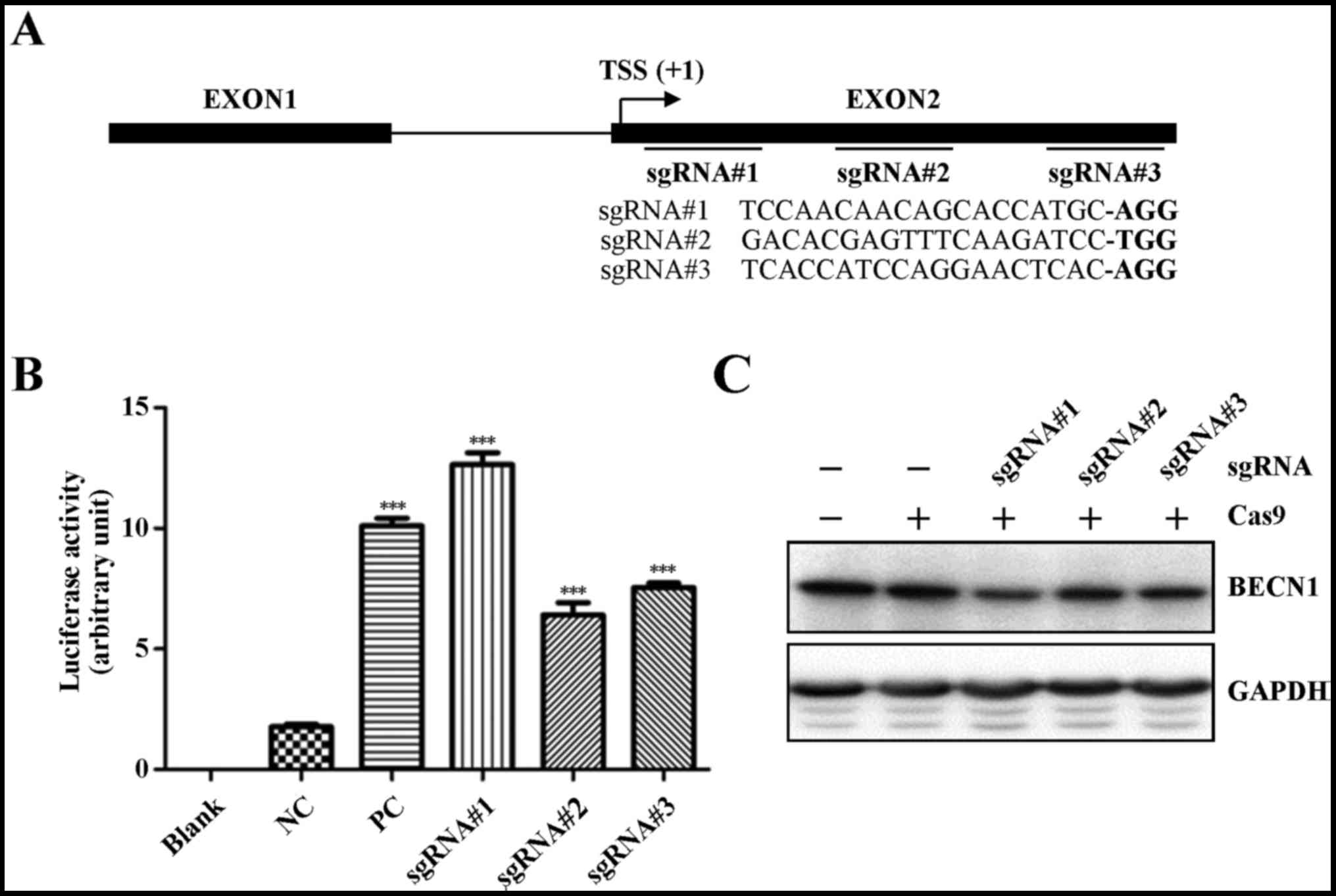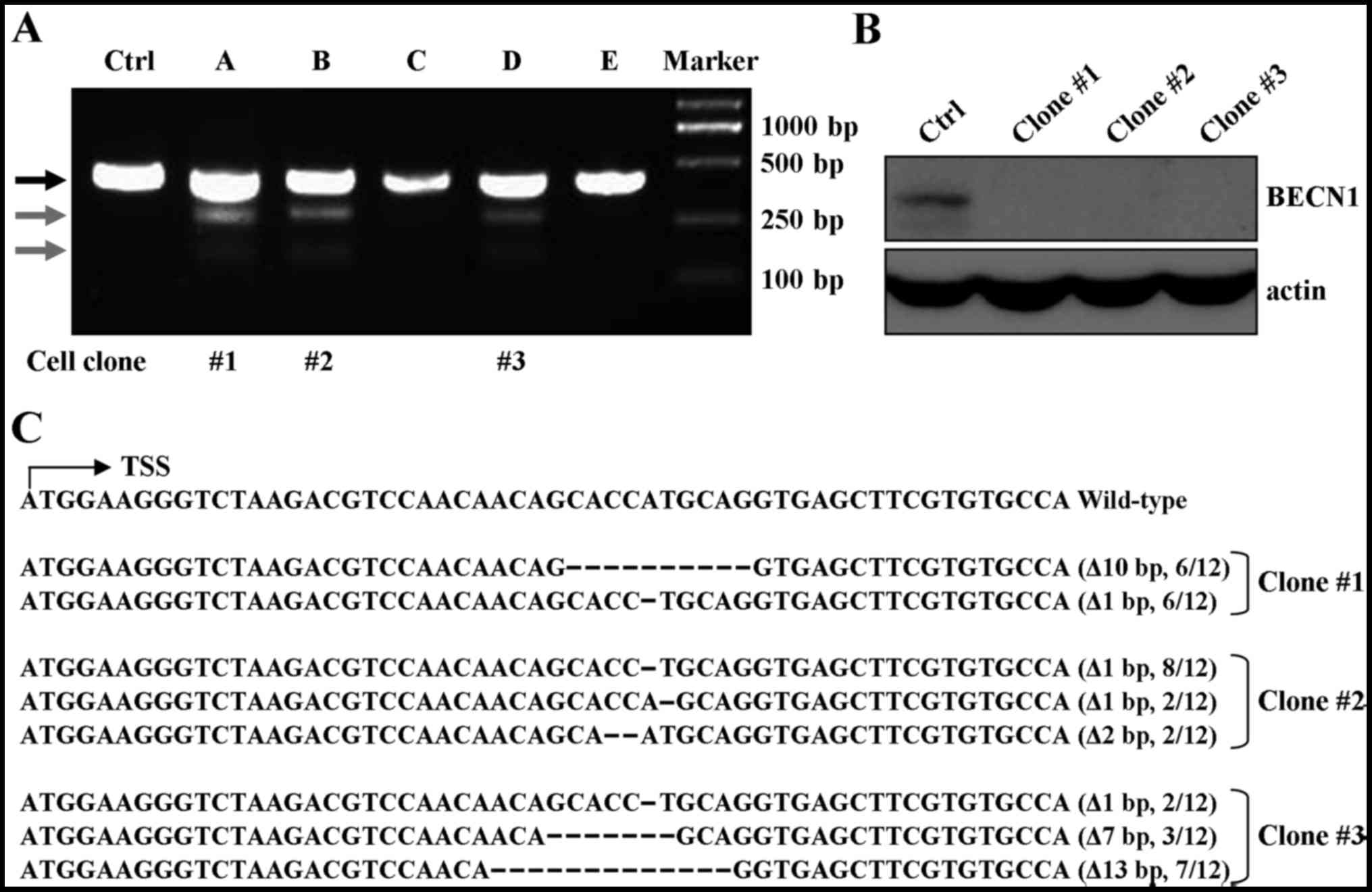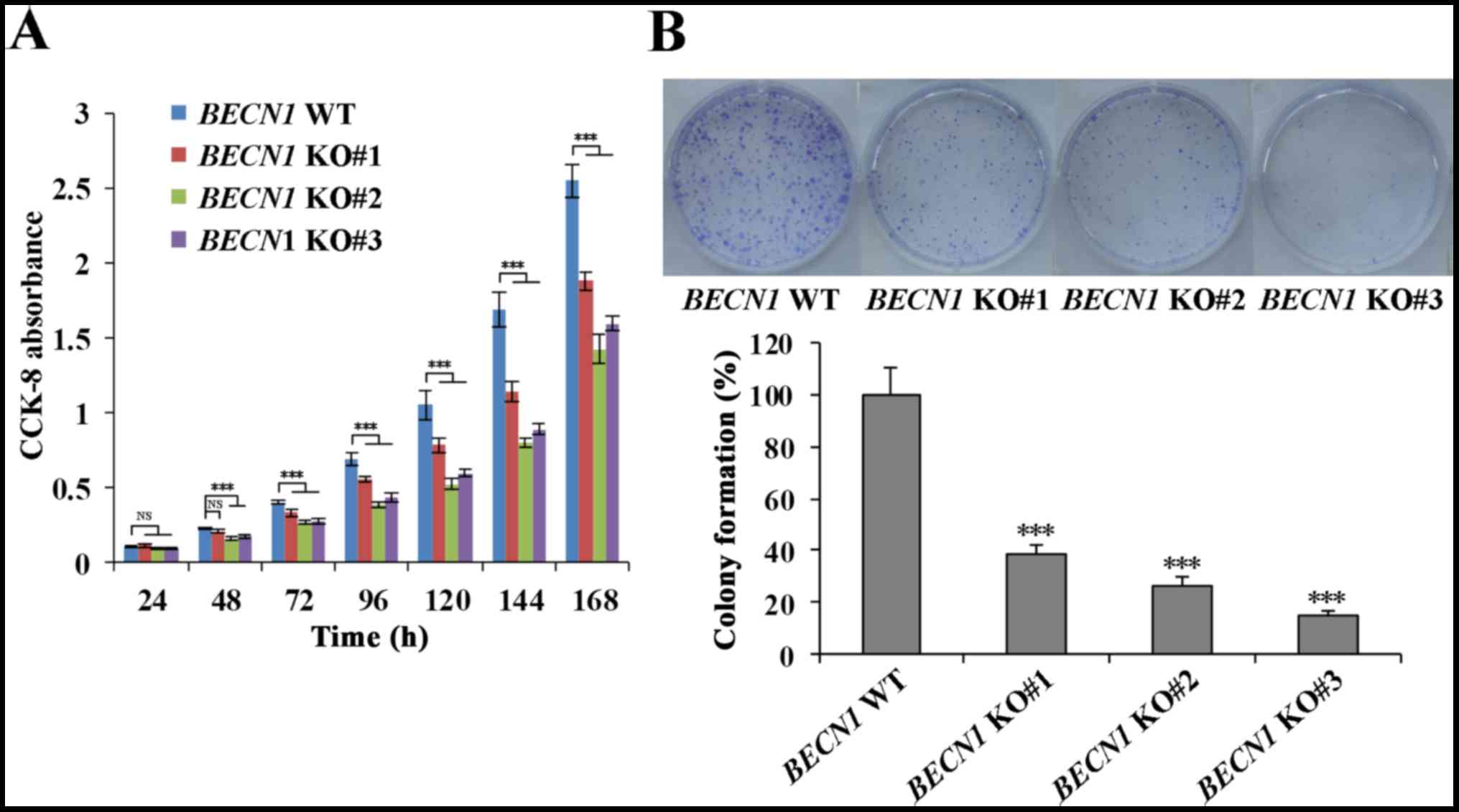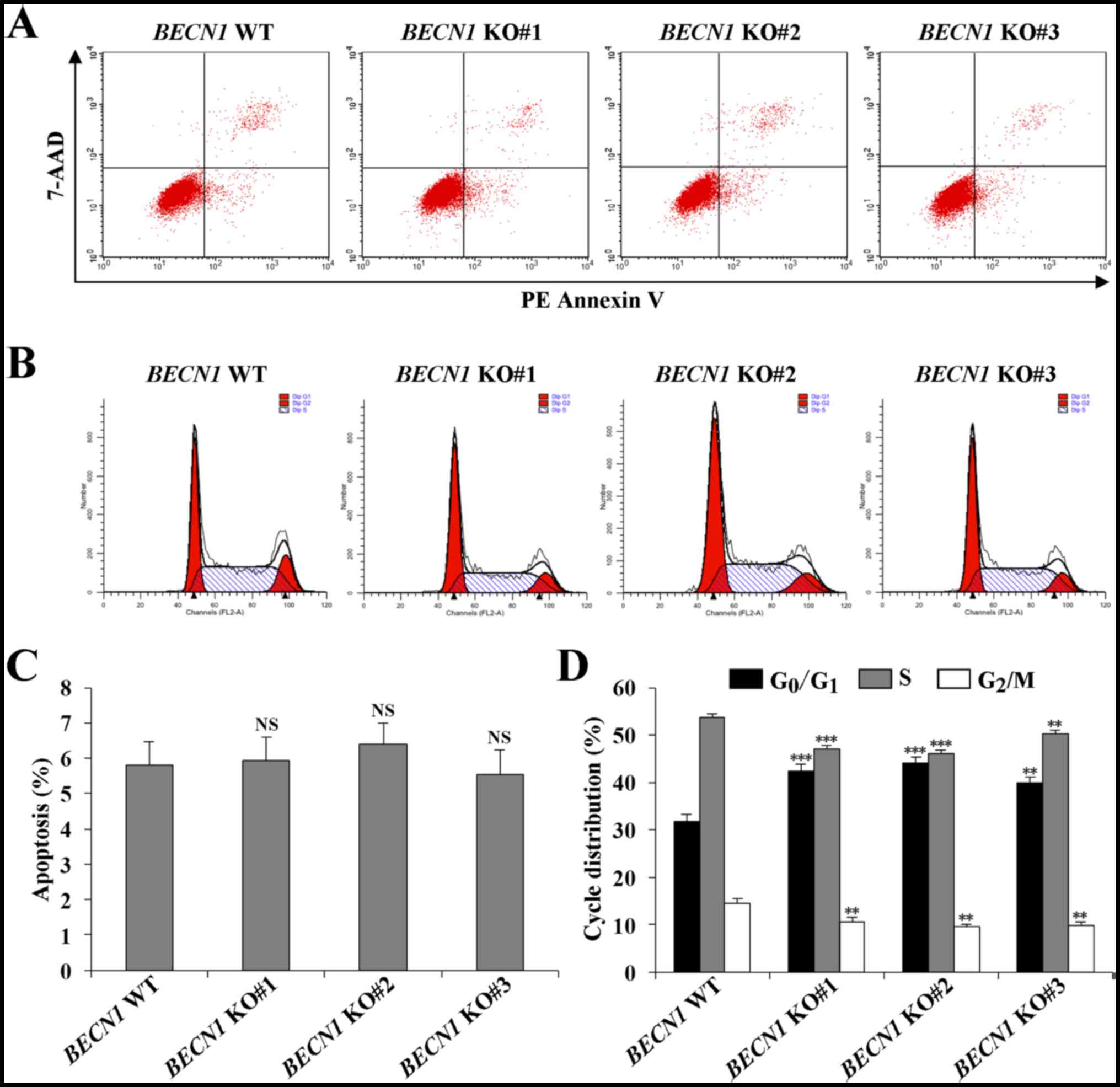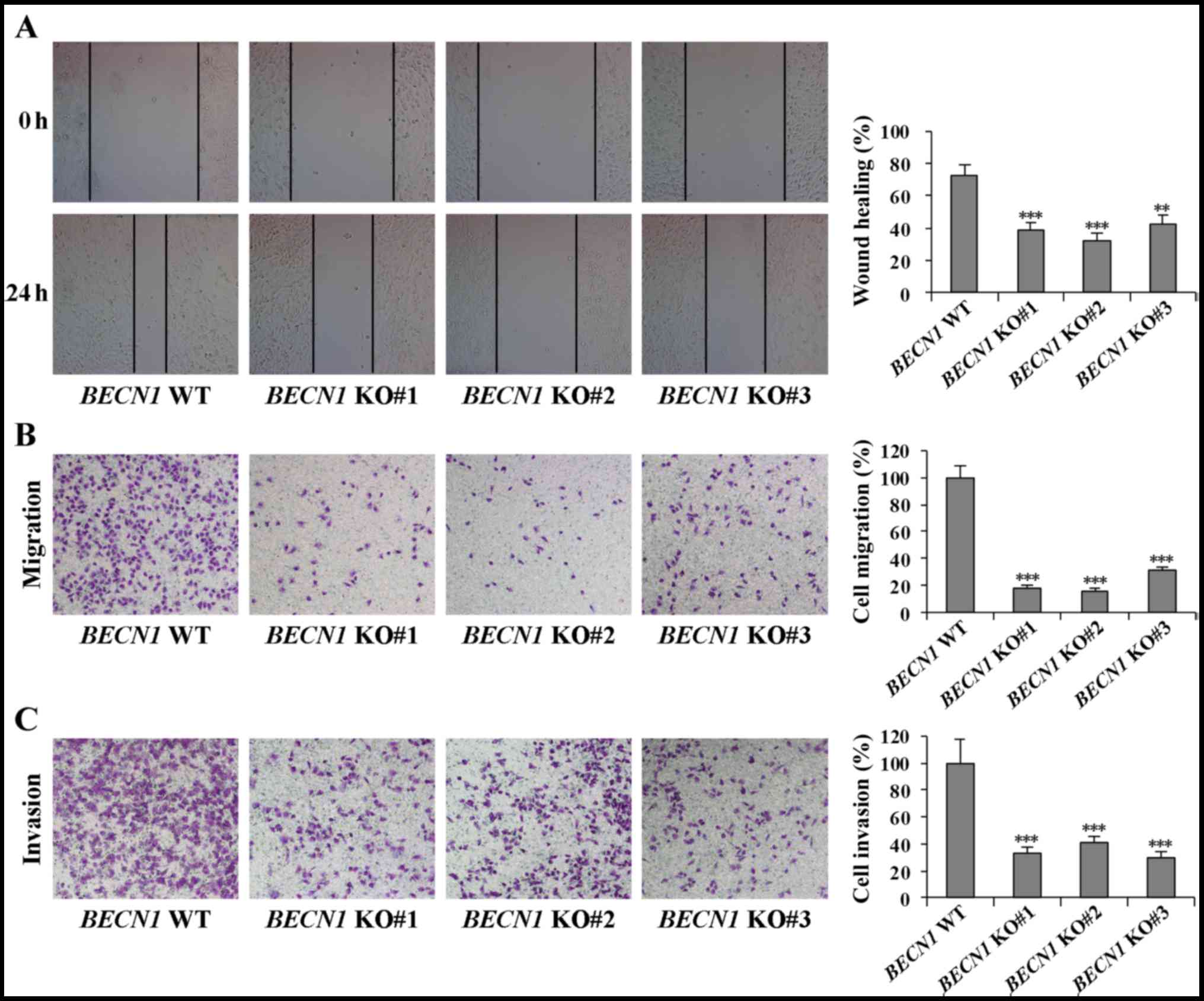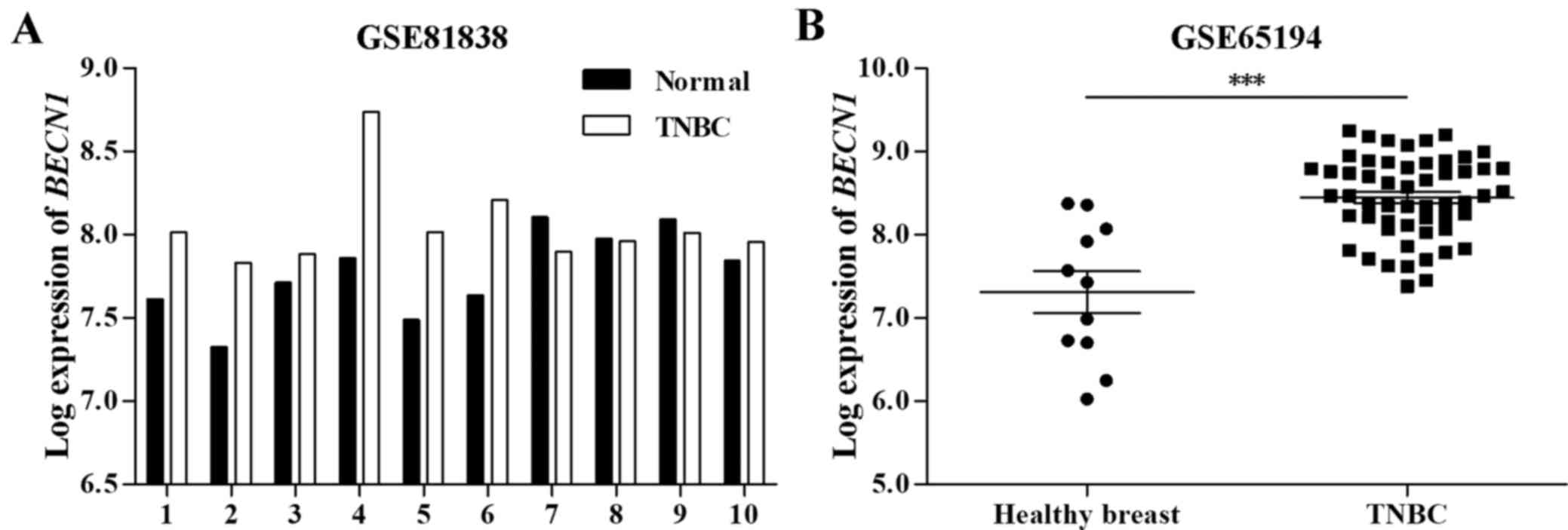Introduction
Beclin1 (BECN1), a coiled-coil protein, directly
interacts with B-cell lymphoma 2 (Bcl-2) (1). BECN1, also known as ATG6, belongs to
the autophagy-related (Atg) family, key molecules in regulating
autophagy (2,3). BECN1 acts downstream of Ulk1 and
protein kinase B (Akt) to initiate phagophore formation (4,5).
BECN1 is monoallelically deleted in 40–75% of
breast, ovarian and prostate cancer cases (6) and is most likely a haplo-insufficient
tumor suppressor (7–9). BECN1 has the potential to
predict a favorable prognosis in gastric cancer, breast cancer, and
lymphoma (10). However, the exact
role of BECN1 in breast cancer is not fully understood.
Monoallelic loss of Becn1 may promote breast cancer
development in Wnt1-driven tumorigenesis, suggesting a tumor
suppressing role of BECN1 (11). By contrast, monoallelic deletion of
Becn1 promotes the formation of spontaneous lung cancer,
liver cancer and lymphomas, but only led to mammary hyperplasia in
C57BL/6J mice (8) and does not
affect ERBB2- and PyMT-driven mammary tumorigenesis
in immortalized mouse mammary epithelial cells (iMMECs) (12). Furthermore, monoallelic
Becn1 loss inhibits Palb2-associated mammary
tumorigenesis in a Trp53-wild-type background (13). Gong et al (14) also demonstrated that BECN1
promotes tumorigenicity in breast cancer stem-like cells. These
seemingly paradoxical roles of BECN1 in breast cancer
progression may be explained by various cellular contexts resulting
in different consequences. In addition, bi-allelic knockout of
Becn1 leads to embryolethality in a mouse model, hindering
further investigation (9). To
further investigate the function of BECN1 in breast cancer,
the present study used the CRISPR/Cas9 system to disrupt the
BECN1 gene in the human triple-negative breast cancer (TNBC)
MDA-MB-231 cell line. Since being improved to edit mammalian genes
(15), CRISPR/Cas9 has been widely
used to edit genes in numerous species (16–18).
In the present study, BECN1 was successfully
disrupted in MDA-MB-231 cells and three stable monoclonal
BECN1-knockout cell lines were screened for the first time.
The MDA-MB-231 cells with BECN1-knockout exhibited markedly
decreased proliferation, colony formation, migration and invasion
accompanied by G0/G1 cell cycle arrest and a
partial epithelial-mesenchymal transition (EMT) signal reversal
in vitro. On the other hand, it was demonstrated that
BECN1 expression was increased in TNBC samples. Therefore,
the results of the present study provide solid evidence for the
oncogenic role of BECN1 in TNBC growth, migration and
invasion.
Materials and methods
Cell culture
The human TNBC MDA-MB-231 cell line, human
epithelial breast cancer BT-474 cell line and human embryonic
kidney 293T and 293A cell lines were purchased from the American
Type Culture Collection (Manassas, VA, USA), and were cultured in
Dulbecco's modified Eagle's medium (DMEM), supplemented with 10%
fetal bovine serum (FBS; both Thermo Fisher Scientific, Inc.,
Waltham, MA, USA) at 37°C in a humidified 5% CO2
atmosphere.
Construction of plasmids
Three G(N19)NGG sequences downstream from the
BECN1 TSS were selected as potential targeting sites. N
indicates any nucleotide (A, T, G or C). The three targeting sites
were as follows: B432, GTCCAACAACAGCACCATGCAGG; B497,
GGACACGAGTTTCAAGATCCTGG; and
B525, GTCACCATCCAGGAACTCACAGG. To
construct B432, B497 and B525 sgRNA lentiviral plasmids, respective
primer pairs were used as a template for CRIF and CRIR PCR
amplification in separate reactions (Table I). The PCR product was inserted
into the pLKO.1 plasmid (Sigma-Aldrich; Merck KGaA, Darmstadt,
Germany) using Gibson master mix (New England Biolabs, Inc.,
Ipswich, MA, USA). The flag-tagged Cas9 gene was cloned into the
pShuttle-CMV plasmid (a gift from Dr Pu-Min Zhang) at the
BglII and XhoI restriction sites. Following
linearizing with PmeI, pShuttle-CMV-Cas9 was co-transformed
with the pAdEasy-1 plasmid (a gift from Dr Pu-Min Zhang) into
BJ5183 cells (Stratagene; Agilent Technologies, Inc., Santa Clara,
CA, USA), according to the manufacturer's protocol. Following
incubation overnight at 37°C, positive clones selected on LB plates
containing 50 µg/ml kanamycin (Sigma-Aldrich; Merck KGaA)
were identified by digesting with PacI.
 | Table IOligonucleotides used in the present
study. |
Table I
Oligonucleotides used in the present
study.
|
Oligonucleotide | Sequence |
|---|
| B432_F |
5′-GAAAGGACGAAACACCGTC
CAACAACAGCACCATGCGTTTTAGAGCTAGAAAT-3′ |
| B432_R |
5′-ATTTCTAGCTCTAAAACGCA
TGGTGCTGTTGTTGGACGGTGTTTCGTCCTTTC-3′ |
| B497_F |
5′-GAAAGGACGAAACACCGGAC
ACGAGTTTCAAGATCCGTTTTAGAGCTAGAAAT-3′ |
| B497_R |
5′-ATTTCTAGCTCTAAAACGGAT
CTTGAAACTCGTGTCCGGTGTTTCGTCCTTTC-3′ |
| B525_F |
5′-GAAAGGACGAAACACCGTC
ACCATCCAGGAACTCACGTTTTAGAGCTAGAAAT-3′ |
| B525_R |
5′-ATTTCTAGCTCTAAAACGTGAG
TTCCTGGATGGTGACGGTGTTTCGTCCTTTC-3′ |
| CRI_F |
5′-GTATTTCGATTTCTTGGCTTTATA
TATCTTGTGGAAAGGACGAAACACCG-3′ |
| CRI_R |
5′-GTTGATAACGGACTAGCCTTATT
TTAACTTGCTATTTCTAGCTCTAAAAC-3′ |
| B371_F |
5′-GGCGTCGCTTCTCCCTAATGTTG-3′ |
| B793_R |
5′-GCCCGCCTCGGTCTCCCAAAATGC-3′ |
| N-cadherin_F |
5′-AGCCAACCTTAACTGAGGAGT-3′ |
| N-cadherin_R |
5′-GGCAAGTTGATTGGAGGGATG-3′ |
| Vimentin _F |
5′-CGAAAACACCCTGCAATCTT-3′ |
| Vimentin _R |
5′-CTGGATTTCCTCTTCGTGGA-3′ |
| Claudin-1_F |
5′-GTCATTGGGGGTGCGATA-3′ |
| Claudin-1_R |
5′-GGTGTTGGGTAAGAGGTTGTTT-3′ |
| Snail_F |
5′-CCTGCGTCTGCGGAACCT-3′ |
| Snail_R |
5′-CCTGGCACTGGTACTTCTTGACA-3′ |
| GAPDH_F |
5′-ACGGATTTGGTCGTATTGGG-3′ |
| GAPDH_R |
5′-TGATTTTGGAGGGATCTCGC-3′ |
| E-cadherin_F |
5′-GCCTCCTGAAAAGAGAGTGGAAG-3′ |
| E-cadherin_R |
5′-TGGCAGTGTCTCTCCAAATCCG-3′ |
CRISPR efficiency evaluation
The UCA™ CRISPR efficiency evaluation kit was
purchased from Beijing Biocytogen Co., Ltd. (Beijing, China).
Briefly, the targeting sequence of BECN1 amplified with the
primer set B371_F and B793_R (Table
I) was cloned into a precut pUCA plasmid (UCA-BECN1; Beijing
Biocytogen Co., Ltd.). The UCA-BECN1, sgRNA and Flag-Cas9 plasmids
were co-transfected into 293T cells using Lipofectamine™ 3000
(Thermo Fisher Scientific, Inc.). Approximately 48 h after
transfection, cells were lysed and luciferase activity was measured
using the dual-luciferase reporter assay (Promega Corporation,
Madison, WI, USA) with a Lumat LB 9501 Luminometer (Berthold
Technologies GmbH & Co., Bad Wildbad, Germany). CRISPR
efficiency was calculated as the ratio of firefly luciferase to
Renilla luciferase activity.
Lentivirus and adenovirus packaging and
infection
To package the sgRNA lentivirus, the sgRNA plasmid
and packaging plasmids, pMD and SPA were co-transfected into 293T
cells as described earlier. The supernatant was harvested 48 h
after transfection and used to infect MDA-MB-231 cells. The
recombinant Ad plasmid was linearized with PacI and
transfected into 293A cells using Lipofectamine™ 3000 (Thermo
Fisher Scientific, Inc.) to produce Cas9 adenovirus. Infected
MDA-MB-231 cells were screened for sgRNA-positive cells by adding 2
µg/ml puromycin (Sigma-Aldrich; Merck KGaA) for one week.
Puromycin-resistant cells were further infected with Cas9
adenovirus for 12 h. After 4 days of culture, the cells were well
prepared for the subsequent experiments.
Cell genomic DNA extraction and target
sequence amplification
The genomic DNA of MDA-MB-231 cells was extracted
using a Qiagen Genomic kit (Qiagen GmbH, Hilden, Germany). Next,
the genomic region surrounding the CRISPR/Cas9 target site was
amplified by PCR using the primer set, B371_F and B793_R (Table I). PCR was performed using
GoTaq® Green Master mix (Promega Corporation) in an ABI
2720 Thermal cycler (Applied Biosystems; Thermo Fisher Scientific,
Inc.) as follows: 95°C for 2 min; 33 cycles at 95°C for 30 sec,
60°C for 30 sec and 72°C for 30 sec; and 72°C for 5 min. The 423-bp
PCR product was verified using 1.5% agarose gel electrophoresis and
then purified using the QIAquick® gel extraction kit
(Qiagen GmbH).
T7 Endonuclease I (T7EI) digestion
assay
T7EI was purchased from NEB. Prior to T7EI
digestion, the PCR product amplified using the primer set, B371_F
and B793_R (Table I), was
denatured and annealed. In brief, the PCR product was incubated in
94°C water and cooled to room temperature naturally. The PCR
product was then digested with T7EI at 37°C for 2 h and resolved
with 1.5% agarose gel electrophoresis.
Sequencing analysis of a single cell
colony
The genomic DNA of a single cell colony was
extracted using a Qiagen Genomic kit (Qiagen GmbH) and amplified
using the primer set, B371_F and B793_R (Table I). Following purification, the PCR
product was ligated into the pGEM-T Easy vector (Promega
Corporation). The ligation product was used to transform competent
E. coli DH5α (Thermo Fisher Scientific, Inc.), and positive
clones selected on LB plates containing 100 µg/ml ampicillin
(Sigma-Aldrich; Merck KGaA) were sequenced using the universal T7
primer.
Western blotting
Cells were lysed using radioimmunoprecipitation
assay buffer (Applygen Technologies Inc., Beijing, China)
supplemented with protease and phosphatase inhibitors (Roche
Diagnostics GmbH, Mannheim, Germany). The concentration of the
protein was determined by Pierce™ bicinchoninic acid protein assay
kit (Thermo Fisher Scientific, Inc.). Protein lysate (20 µg
per lane) was separated by 10% SDS-PAGE gel and transferred onto
nitrocellulose membranes (EMD Millipore, Billerica, MA, USA). The
membranes were blocked with 5% skimmed milk (BD Biosciences, San
Jose, CA, USA) in TBST for 2 h at room temperature and incubated
overnight at 4°C with the following primary antibodies: BECN1
(dilution, 1:2,000; cat. no. sc-11427; Santa Cruz Biotechnology,
Inc., Dallas, TX, USA), GAPDH (dilution, 1:2,000; cat. no.
sc-365062; Santa Cruz Biotechnology, Inc.), N-cadherin (dilution,
1:1,000; cat. no. 13116; Cell Signaling Technology, Inc., Danvers,
MA, USA), Snail (dilution, 1:1,000; cat. no. 3879; Cell Signaling
Technology, Inc.), Claudin-1 (dilution, 1:1,000; cat. no. 13255;
Cell Signaling Technology, Inc.), E-cadherin (dilution, 1:1,000;
cat. no. 3195; Cell Signaling Technology, Inc.) and Vimentin
(dilution, 1:8,000; cat. no. ab92547; Abcam, Cambridge, UK). Next,
the membranes were incubated with horseradish peroxidase-conjugated
anti-rabbit or anti-mouse secondary antibodies (dilution, 1:5,000;
cat. no. 7074 and 7076; Cell Signaling Technology, Inc.) for 1 h at
room temperature. Bands were visualized using an enhanced
chemiluminescence reagent (EMD Millipore).
Reverse transcription-quantitative
polymerase chain reaction (qPCR)
Total RNA was isolated using TRIzol reagent (Thermo
Fisher Scientific, Inc.). Next, reverse transcription of 2
µg total RNA was performed using Superscript™ III
transcriptase (Thermo Fisher Scientific, Inc.). Regarding qPCR,
cDNA was amplified using THUNDERBIRD SYBR qPCR mix (Toyobo Life
Science, Osaka, Japan) in a Chromo4™ system (Bio-Rad Laboratories,
Inc., Hercules, CA, USA). PCR started with a 10-min denaturation
step at 95°C, followed by 40 step cycles at 95°C for 15 sec and
60°C for 60 sec. The expression of N-cadherin, Vimentin, Claudin-1,
Snail and E-cadherin was analyzed using the primers shown in
Table I. GAPDH was used as an
internal control for normalization. The 2−∆∆Cq method
was used to calculate the relative expression levels (19).
Cell Counting kit 8 (CCK-8) and colony
formation assays
For the CCK-8 assay, MDA-MB-231 cells (1,000
cells/well) were seeded into 96-well plates and incubated for 7
consecutive days. CCK-8 assays were performed in quintuplicate and
proliferation of cells was measured by adding 10 µl CCK-8
reagent (Dojindo Molecular Technologies, Inc., Kumamoto, Japan) to
each well at different time-points. Plates were incubated at 37°C
for 2.5 h and absorbance was evaluated using a microplate reader
(Bio-Rad Laboratories, Inc.) at 450 nm.
For the colony formation assay, MDA-MB-231 cells
(1,000 cells/well) were plated into 6-well plates. Cells were
cultured for up to 14 days and fresh DMEM supplemented with 10% FBS
(both Thermo Fisher Scientific, Inc.) was changed every 3 days.
Cells were fixed in paraformaldehyde for 10 min at room temperature
and stained with crystal violet for 15 min at room temperature.
Colonies with >50 cells were counted.
Flow cytometric analysis
For the apoptosis assay, cells were stained using
the PE Annexin V Apoptosis Detection kit I (BD Biosciences),
according to the manufacturer's protocol. In brief, cells were
digested with trypsin without EDTA, washed two times with PBS and
resuspended in 100 µl binding buffer, followed by
simultaneous staining with 5 µl PE Annexin V and 5 µl
7-AAD for 15 min at room temperature in the dark, and then analyzed
using a flow cytometer (BD Biosciences).
For cell cycle analysis, cells were harvested and
fixed in cold 70% alcohol at 4°C overnight. Cells were collected by
centrifugation (800 × g for 5 min at room temperature), washed
twice in PBS and incubated with FxCycle™ PI/RNase Staining Solution
(Thermo Fisher Scientific, Inc.) for 30 min at room temperature in
the dark. Cell cycle distribution was then evaluated using a flow
cytometer and CellQuest™ software (version 6.0; BD
Biosciences).
Wound healing assay
For the wound healing assay, cells were seeded into
6-well plates and an artificial wound was made using a sterile 200
µl pipette tip. Following rinsing with PBS, cells were
incubated in serum-free DMEM (Thermo Fisher Scientific, Inc.).
Images of the scratch gap were captured at 0 and 24 h under a light
microscope (magnification, ×100; Eclipse Ti-U; Nikon Corporation,
Tokyo, Japan). The percentage of wound healing was evaluated as
follows: [1− (width of the wound at 24 h/width of the wound at 0
h)] ×100.
Transwell migration and invasion
assays
Transwell chambers (8 µm-pore size; Corning
Incorporated, Corning, NY, USA) coated with or without diluted
Matrigel (BD Biosciences) on the upper chamber were used for
invasion or migration assays. Briefly, 5×104 MDA-MB-231
cells in serum-free DMEM (Thermo Fisher Scientific, Inc.) were
seeded into the upper chamber and medium supplemented with 10% FBS
was added to the lower chamber. Following culture for 8 or 24 h,
cells remaining on the upper side of the filter membrane were
gently wiped off using a cotton swab, while cells that migrated or
invaded the lower chamber were fixed with paraformaldehyde for 10
min at room temperature and stained with crystal violet for 15 min
at room temperature. Cells were counted in five different randomly
selected fields under a light microscope (magnification, ×100;
Nikon Corporation).
GEO database analysis
Gene expression data (accession nos., GSE81838 and
GSE65194) were retrieved from the NCBI Gene Expression Omnibus
(GEO) database. Details of patients and analysis of microarray data
were as previously described (20,21).
GSE81838 consisted of 10 paired TNBC tissues and adjacent normal
stromal tissues, and GSE65194 contained 41 TNBC samples and 11
normal breast tissue samples. Expression data from GSE81838 were
normalized using the Robust MultiChip Averaging (RMA) algorithm
implemented in the Bioconductor package Affy and log2-transformed.
Data from GSE65194 were analyzed using standard AffyCDF or
Brainarray HGU133Plus2_Hs_ENTREZG version 13 custom chipset
definition file and normalized using GeneChip RMA (GC-RMA).
Statistical analysis
SPSS version 19.0 software (IBM Corp., Armonk, NY,
USA) was used for statistical analyses. Data are presented as the
mean ± standard deviation (SD) and error bars represent SD values
from three independent experiments, unless otherwise indicated.
Multiple-group comparisons were performed using one-way analysis of
variance, followed by the Bonferroni's post hoc test. Comparisons
between two groups were calculated using the two-sample t-test.
P<0.05 was considered to indicate a statistically significant
difference.
Results
Establishing BECN1-knockout MDA-MB-231
cell lines
Becn1 bi-allelic knockout mice die early in
embryogenesis (9), which hampers
further investigation of the functions of BECN1 in autophagy
and tumorigenesis. In order to determine if cells survive following
BECN1-knockout, the CRISPR/Cas9 technique was used to
establish a BECN1-knockout cell line. Using the free online
bioinformatical sgRNA design tool (http://crispr.mit.edu/) developed by Dr Feng Zhang,
the genomic and cDNA sequences downstream of the translation start
site (TSS) were analyzed. As demonstrated in Fig. 1A, three sequences with the highest
scores were selected to construct sgRNA lentivirus vectors. In
order to assess vector efficiency, a luciferase reporter assay was
performed (Fig. 1B). Luciferase
assay data indicated that sgRNA#1 had the highest efficiency, which
was also confirmed by western blot analysis (Fig. 1C).
Based on the aforementioned results, sgRNA#1 was
selected to package the lentivirus that was used to infect
MDA-MB-231 cells. Puromycin-resistant cells were further infected
with Cas9 adenovirus. Following serial dilution and culturing for
up to two weeks, >20 single cell colonies were subjected to T7
Endonuclease I (T7EI) digestion. Five clones were subjected to a
second round of T7EI digestion (Fig.
2A). Clones A, B and D (renamed KO#1, KO#2 and KO#3,
respectively) were selected for western blotting and sequencing
verification. Western blotting verified that BECN1 was not
expressed in these three clones (Fig.
2B). Sequencing indicated that the loss of BECN1 expression was
due to multiple InDels occurring at the BECN1 locus, all of
which led to frame shifts and subsequent gene knockout (Fig. 2C). Taken together, the results
indicated that stable cell lines that could survive following
BECN1-knockout were successfully constructed.
BECN1-knockout inhibits proliferation and
colony formation of MDA-MB-231 cells via inducing cell cycle
arrest, not apoptosis
Since MDA-MB-231 cells with BECN1-knockout
were able to survive, the effect of BECN1-knockout on cell
growth was analyzed by comparing the viability of
BECN1-knockout and wild-type (WT) MDA-MB-231 cells between
24 and 168 h after inoculation. As demonstrated in Fig. 3A, no significant difference in the
viability of BECN1-knockout MDA-MB-231 cells was observed
when compared with WT cells at 24 h. However, when compared with WT
MDA-MB-231 cells, BECN1 KO#1 cells exhibited markedly
decreased proliferation after 72 h, and the proliferation of
BECN1 KO#2 and KO#3 cells was significantly inhibited after
48 h in culture (P<0.001). The colony formation assay is an
in vitro approach to evaluate the ability of a single cell
to grow into a colony and essentially tests every cell within a
population for its ability to undergo 'unlimited ' division
(22). It was also determined that
BECN1-knockout inhibited the colony formation capacity of
MDA-MB-231 cells (P<0.001; Fig.
3B). Therefore, BECN1-knockout MDA-MB-231 cells retained
growth capability but exhibited an attenuated proliferation
rate.
Next, flow cytometry was performed to investigate
whether the anti-proliferative effect of BECN1-knockout was
due to apoptosis or cell cycle arrest. There was no significant
difference in apoptosis in the BECN1-knockout MDA-MB-231
cells compared with WT (Fig. 4A and
C). However, all three BECN1-knockout cell lines
accumulated at the G0/G1 phase with decreased
cell proportions in the S and G2/M phases compared with
WT (Fig. 4B and D). The percentage
of G0/G1 cells significantly increased from
31.7±1.6% (WT) to 42.5±1.3% (KO#1; P<0.001), 44.1±1.2% (KO#2;
P<0.001) and 39.9±1.3% (KO#3; P<0.01). These results
suggested that BECN1-mediated autophagy or other pathways
serve an important role in cancer cell proliferation via regulation
of cell cycle progression.
BECN1-knockout suppresses MDA-MB-231 cell
migratory and invasive potential by partially attenuating EMT
signals
Subsequently, whether BECN1 affects the tumor
metastasis characteristics of migratory and invasive ability in
MDA-MB-231 cells was investigated. The wound healing assay revealed
that MDA-MB-231 cells with BECN1-knockout exhibited a
notably slower scratch closure rate than WT cells (Fig. 5A), which suggested mobility
inhibition. The Transwell migration assay further confirmed that
BECN1-knockout markedly reduced the migratory ability of
MDA-MB-231 cells (Fig. 5B).
Furthermore, the invasive potential of BECN1-knockout
MDA-MB-231 cells was significantly decreased (Fig. 5C), which was confirmed by the
Transwell invasion assay. In brief, the results of the present
study demonstrated that BECN1-knockout markedly decreased
the migratory and invasive potential of MDA-MB-231 cells in
vitro.
To test whether the effect of BECN1-knockout
on migration and invasion is associated with EMT, the present study
assessed the cell morphology under a phase contrast microscope. As
demonstrated in Fig. 6A,
BECN1-knockout changed the mesenchymal morphology of
MDA-MB-231 cells into a partial epithelial-like morphology with
decreased cell scattering and increased cell-cell adhesion.
Consistent with the morphology changes, expression of mesenchymal
markers, including N-cadherin, Vimentin and Snail decreased, while
expression of the epithelial marker Claudin-1, but not E-cadherin,
increased following BECN1-knockout (Fig. 6B–D), suggesting a partial reversal
of EMT. Taken together, the results of the present study
demonstrated that BECN1 regulates breast cancer cell
migration and invasion via partial modulation of the EMT signaling
pathway.
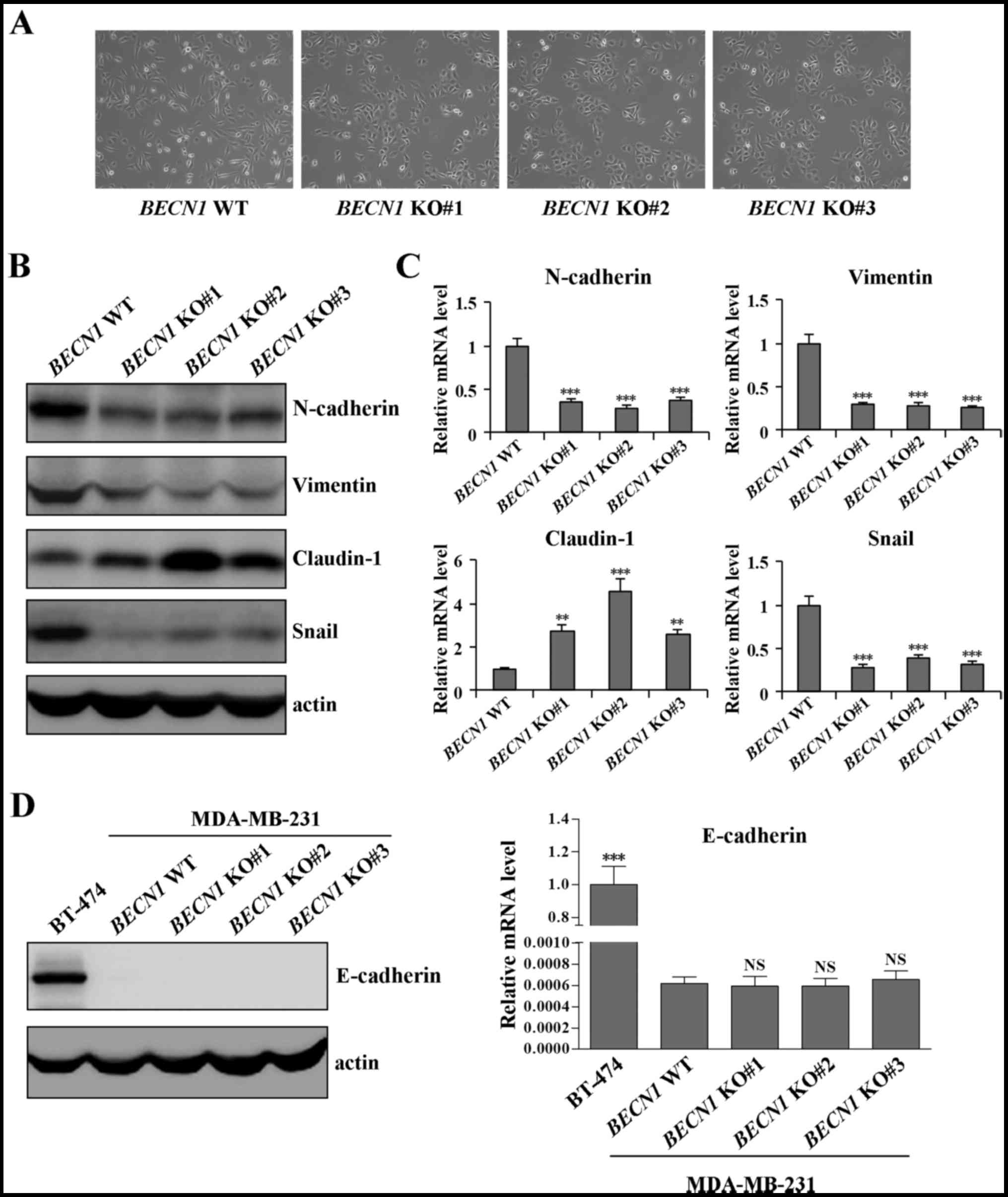 | Figure 6BECN1 partially modulates EMT
phenotype in MDA-MB-231 cells. (A) Phase contrast images of
BECN1 WT and KO MDA-MB-231 cells (magnification, ×100). (B)
Protein levels of tumor EMT markers (N-cadherin, Vimentin,
Claudin-1 and Snail) in BECN1 WT and KO MDA-MB-231 cells
were detected using western blotting with respective antibodies.
Actin served as the internal control. (C) RNA levels of N-cadherin,
Vimentin, Claudin-1 and Snail in BECN1 WT and KO MDA-MB-231
cells were determined using qPCR. The relative mRNA levels were
normalized to GAPDH. (D) BECN1-knockout does not affect the
expression of E-cadherin in MDA-MB-231 cells. E-cadherin protein
was detected using western blotting (left panel) and RNA expression
was determined using qPCR (right panel). E-cadherin expression in
the epithelial breast cancer BT-474 cell line was used as a
positive control. NS, not significant (P>0.05);
**P<0.01; ***P<0.001 vs. WT MDA-MB-231
cells. qPCR, quantitative polymerase chain reaction; BECN1,
Beclin1; EMT, epithelial-mesenchymal transition; WT, wild-type; KO,
knockout. |
BECN1 expression is increased in TNBC
tissue samples
To determine whether the expression of BECN1
is altered in TNBC tissues, a GEO dataset (GSE81838) containing ten
patients with TNBC was analyzed (20). The results demonstrated that
BECN1 was significantly upregulated in half of the TNBC
tissues compared with adjacent normal stromal tissues (Fig. 7A; P<0.05). Meanwhile, another
GEO dataset (GSE65194) containing 41 TNBC samples and 11 normal
breast tissue samples was analyzed (21). BECN1 expression was
significantly increased in tumor tissues compared with healthy
breast tissues (Fig. 7B;
P<0.001). The results suggested that BECN1 may serve as
an oncogene in TNBC.
Discussion
A large volume of data has implied the important
role of BECN1 in autophagy and tumorigenesis. Unfortunately,
the embryolethality of Becn1 bi-allelic knockout has largely
affected further investigation of BECN1 function (9). The function of BECN1 in
tumorigenesis remains controversial, and may be tissue- and
context-dependent. While mammary tumor development was either
inhibited or unaffected following loss of Palb2, or
overexpression of PyMT and ERBB2, monoallelic
Becn1 loss accelerates mammary tumorigenesis following
parity and Wnt1-activation (11–13).
Fortunately, CRISPR/Cas9-mediated gene disruption at the single
cell level shed light on this problem. Using the CRISPR/Cas9
technique, BECN1 was successfully disrupted in human TNBC
MDA-MB-231 cells and screened three monoclonal cells with
BECN1-knockout. In a previous study, Aita et al
(6) demonstrated that MDA-MB-231
cells have three BECN1 loci. The present study revealed that
cell clone #2 and #3 harbored three disruptions in BECN1.
Clone #1 only had two versions, which may be due to two loci of
BECN1 being the same. In brief, these BECN1-knockout
cell lines provided an ideal cellular model for the investigation
into BECN1 function and demonstrated that
BECN1-knockout is not lethal in vitro.
BECN1 was first identified as a mammalian
tumor suppressor by Liang et al (7). BECN1 expression is decreased in human
breast epithelial carcinoma cell lines and tissues at the protein
level, and induction of BECN1 into MCF-7 cells suppresses
proliferation, colony formation in vitro and tumor formation
in nude mice (7). However, Gong
et al (14) demonstrated
that BECN1 is critical for the maintenance of cancer
stem-like cells and tumor development in nude mice. Maycotte et
al (23) also discovered that
knockdown of BECN1 by shRNA inhibits clonogenic
proliferation of MDA-MB-231 cells. The present study demonstrated
that BECN1 promoted cell proliferation and colony formation
in MDA-MB-231 cells. These results and those of previous studies
suggested that BECN1 could function as an oncogene and a
tumor suppressor under distinct cellular contexts.
Tumor growth is usually associated with apoptosis
and/or cell cycle alterations. Apoptosis is characterized by clear
morphological changes, including nuclear condensation and
fragmentation, as well as blebbing of the plasma membrane leading
to the formation of apoptotic bodies (24). Ectopic overexpression of
BECN1 does not affect apoptosis under normal culture
conditions but inhibits apoptosis induced by starvation, hypoxia
and doxorubicin in TNBC cells in vitro (25). Additionally, suppression of
BECN1 promotes apoptosis induced by epirubicin (26), tamoxifen (27,28)
and lapatinib (29) in breast
cancer cells. In the present study, there was no change in the
apoptosis of MDA-MB-231 cells following BECN1-knockout. By
contrast, BECN1-knockout induced a significant
G0/G1 phase arrest and decreased the
proportion of cells in the S and G2/M phases. As a
control for cell growth and proliferation, when facing unfavorable
conditions or external stress, cells block the cell cycle
transiently or irreversibly, which prevents spread of damaged and
potentially harmful cells (30,31).
A previous study has demonstrated that mRNA and protein expression
levels of BECN1 are upregulated when released from
synchronization at the G1/S boundary by a double
thymidine block in HeLa cells (32). BECN1 is essential for chromosome
congression and outer kinetochore assembly (33). Inhibition of BECN1 leads to
centrosome amplification (34),
which usually causes abnormal cell division and genome instability.
These results indicated that BECN1 could affect cancer cell
growth by regulating the cell cycle and/or apoptosis depending on
the external environment.
Another hallmark of cancer is invasion and
metastasis (35). High levels of
BECN1 expression are associated with more lymph node and
distant metastasis in patients with TNBC, and overexpression of
BECN1 promotes EMT under starvation conditions in TNBC cells
(25). The present study
demonstrated that BECN1-knockout inhibited the migration and
invasion of MDA-MB-231 cells. Furthermore, the decreased migratory
and invasive ability was associated with a morphological switch in
mesenchymal phenotype to a partial epithelial-like phenotype
following BECN1-knockout. Upon undergoing EMT, cancer cells
convert from a non-invasive epithelial phenotype to an invasive
mesenchymal phenotype to obtain migratory and invasive ability,
allowing degradation of the extracellular matrix and migration to
distant organs (36). Cadherin is
a transmembrane adhesion glycoprotein (37) and the switch from E-cadherin to
N-cadherin is a remarkable change during EMT (38). In the present study, E-cadherin was
not expressed in WT MDA-MB-231 cells, which is consistent with the
results of previous studies (39,40);
and was not increased following BECN1-knockout, but there
was a significant decrease in N-cadherin expression following
BECN1-knockout. Another mesenchymal marker is Vimentin,
which is associated with cancer invasion and a poor prognosis in
various types of cancer (41). In
accordance with the change in N-cadherin expression, Vimentin
expression was also downregulated following BECN1-knockout.
Claudin-1 belongs to the transmembrane protein family, is regarded
as the backbone of tight junctions and is associated with tumor
metastasis (42). However, the
definitive role of Claudin-1 in TNBC is controversial. In patients
with TNBC, the Claudin1-negative phenotype predicts a high risk of
recurrence and death, which suggested an antitumor function of
Claudin-1 (43). However,
silencing Claudin-1 expression using shRNA inhibits the migration
and invasion of MDA-MB-231 cells (44). In the present study, Claudin-1
expression increased following BECN1-knockout in MDA-MB-231
cells, which may be associated with inhibition of Snail and
subsequent transcriptional repression of Claudin-1 (45). Therefore, the decreased migration
and invasion capability following BECN1-knockout could be
explained by a partial EMT reversal of MDA-MB-231 cells.
Although previous reports indicated that breast
cancer harbors frequent allelic deletions and decreased expression
of BECN1 (6,7,46,47),
Laddha et al (48) reported
that there were no changes in the RNA level of BECN1 in
invasive breast carcinoma tissues, compared with normal tissues.
The present study demonstrated that BECN1 was upregulated in
TNBC tissue samples, compared with adjacent normal stromal tissues
and normal breast tissues. Similar expression patterns have been
reported in ovarian cancer (49–51),
gastric cancer (52–54) and hepatocellular carcinoma
(55,56). Correa et al (49) demonstrated that even with prevalent
single-copy loss, BECN1 protein expression remained similar in
high-grade serous ovarian cancer. BECN1 expression is
increased in ovarian cancer compared with benign tumor and normal
ovary tissues (50). However, Shen
et al (51) observed that
expression of BECN1 is reduced in ovarian cancer, compared
with benign and borderline ovarian tumors. In addition, Fei et
al (54) reported that
BECN1 expression in early-stage gastric cancer is
significantly higher, while in late-stage cases levels were lower
than in adjacent normal tissues (54). These seemingly controversial
results may be explained by tumor heterogeneity and the biphasic
function of BECN1 in cancer development.
In conclusion, BECN1-knockout TNBC cell
lines were established using the CRISPR/Cas9 system. The results
indicated that increased BECN1 activates numerous properties
that are associated with the malignant potential in TNBC cells,
including proliferation, colony formation, cell cycle progression,
migration, invasion and a partial EMT.
Abbreviations:
|
TNBC
|
triple-negative breast cancer
|
|
EMT
|
epithelial-mesenchymal transition
|
|
iMMECs
|
immortalized mouse mammary epithelial
cells
|
|
TSS
|
translation start site
|
|
T7EI
|
T7 Endonuclease I
|
|
CCK-8
|
Cell Counting Kit 8
|
|
WT
|
wild-type
|
|
KO
|
knockout
|
Acknowledgments
The authors would like to thank Dr Pu-Min Zhang
(Beijing Proteome Research Center, Beijing, China) for providing
the CRISPR/Cas9 plasmid.
References
|
1
|
Liang XH, Kleeman LK, Jiang HH, Gordon G,
Goldman JE, Berry G, Herman B and Levine B: Protection against
fatal Sindbis virus encephalitis by beclin, a novel
Bcl-2-interacting protein. J Virol. 72:8586–8596. 1998.PubMed/NCBI
|
|
2
|
Kang R, Zeh HJ, Lotze MT and Tang D: The
Beclin 1 network regulates autophagy and apoptosis. Cell Death
Differ. 18:571–580. 2011. View Article : Google Scholar : PubMed/NCBI
|
|
3
|
Funderburk SF, Wang QJ and Yue Z: The
Beclin 1-VPS34 complex–at the crossroads of autophagy and beyond.
Trends Cell Biol. 20:355–362. 2010. View Article : Google Scholar : PubMed/NCBI
|
|
4
|
Russell RC, Tian Y, Yuan H, Park HW, Chang
YY, Kim J, Kim H, Neufeld TP, Dillin A and Guan KL: ULK1 induces
autophagy by phosphorylating Beclin-1 and activating VPS34 lipid
kinase. Nat Cell Biol. 15:741–750. 2013. View Article : Google Scholar : PubMed/NCBI
|
|
5
|
Wang RC, Wei Y, An Z, Zou Z, Xiao G,
Bhagat G, White M, Reichelt J and Levine B: Akt-mediated regulation
of autophagy and tumorigenesis through Beclin 1 phosphorylation.
Science. 338:956–959. 2012. View Article : Google Scholar : PubMed/NCBI
|
|
6
|
Aita VM, Liang XH, Murty VV, Pincus DL, Yu
W, Cayanis E, Kalachikov S, Gilliam TC and Levine B: Cloning and
genomic organization of beclin 1, a candidate tumor suppressor gene
on chromosome 17q21. Genomics. 59:59–65. 1999. View Article : Google Scholar : PubMed/NCBI
|
|
7
|
Liang XH, Jackson S, Seaman M, Brown K,
Kempkes B, Hibshoosh H and Levine B: Induction of autophagy and
inhibition of tumorigenesis by beclin 1. Nature. 402:672–676. 1999.
View Article : Google Scholar : PubMed/NCBI
|
|
8
|
Qu X, Yu J, Bhagat G, Furuya N, Hibshoosh
H, Troxel A, Rosen J, Eskelinen EL, Mizushima N, Ohsumi Y, et al:
Promotion of tumorigenesis by heterozygous disruption of the beclin
1 autophagy gene. J Clin Invest. 112:1809–1820. 2003. View Article : Google Scholar : PubMed/NCBI
|
|
9
|
Yue Z, Jin S, Yang C, Levine AJ and Heintz
N: Beclin 1, an autophagy gene essential for early embryonic
development, is a haploinsufficient tumor suppressor. Proc Natl
Acad Sci USA. 100:15077–15082. 2003. View Article : Google Scholar : PubMed/NCBI
|
|
10
|
He Y, Zhao X, Subahan NR, Fan L, Gao J and
Chen H: The prognostic value of autophagy-related markers beclin-1
and microtubule-associated protein light chain 3B in cancers: A
systematic review and meta-analysis. Tumour Biol. 35:7317–7326.
2014. View Article : Google Scholar : PubMed/NCBI
|
|
11
|
Cicchini M, Chakrabarti R, Kongara S,
Price S, Nahar R, Lozy F, Zhong H, Vazquez A, Kang Y and Karantza
V: Autophagy regulator BECN1 suppresses mammary tumorigenesis
driven by WNT1 activation and following parity. Autophagy.
10:2036–2052. 2014. View Article : Google Scholar : PubMed/NCBI
|
|
12
|
Lozy F, Cai-McRae X, Teplova I, Price S,
Reddy A, Bhanot G, Ganesan S, Vazquez A and Karantza V: ERBB2
overexpression suppresses stress-induced autophagy and renders
ERBB2-induced mammary tumorigenesis independent of monoallelic
Becn1 loss. Autophagy. 10:662–676. 2014. View Article : Google Scholar : PubMed/NCBI
|
|
13
|
Huo Y, Cai H, Teplova I, Bowman-Colin C,
Chen G, Price S, Barnard N, Ganesan S, Karantza V, White E, et al:
Autophagy opposes p53-mediated tumor barrier to facilitate
tumorigenesis in a model of PALB2-associated hereditary breast
cancer. Cancer Discov. 3:894–907. 2013. View Article : Google Scholar : PubMed/NCBI
|
|
14
|
Gong C, Bauvy C, Tonelli G, Yue W,
Delomenie C, Nicolas V, Zhu Y, Domergue V, Marin-Esteban V,
Tharinger H, et al: Beclin 1 and autophagy are required for the
tumorigenicity of breast cancer stem-like/progenitor cells.
Oncogene. 32:2261–2272. 2272e 2261–2211. 2013. View Article : Google Scholar :
|
|
15
|
Cong L, Ran FA, Cox D, Lin S, Barretto R,
Habib N, Hsu PD, Wu X, Jiang W, Marraffini LA, et al: Multiplex
genome engineering using CRISPR/Cas systems. Science. 339:819–823.
2013. View Article : Google Scholar : PubMed/NCBI
|
|
16
|
Wright AV, Nuñez JK and Doudna JA: Biology
and applications of CRISPR Systems: Harnessing nature's toolbox for
genome engineering. Cell. 164:29–44. 2016. View Article : Google Scholar : PubMed/NCBI
|
|
17
|
Sánchez-Rivera FJ and Jacks T:
Applications of the CRISPR-Cas9 system in cancer biology. Nat Rev
Cancer. 15:387–395. 2015. View Article : Google Scholar : PubMed/NCBI
|
|
18
|
Shalem O, Sanjana NE and Zhang F:
High-throughput functional genomics using CRISPR-Cas9. Nat Rev
Genet. 16:299–311. 2015. View Article : Google Scholar : PubMed/NCBI
|
|
19
|
Livak KJ and Schmittgen TD: Analysis of
relative gene expression data using real-time quantitative PCR and
the 2(−Delta Delta C(T)) Method. Methods. 25:402–408. 2001.
View Article : Google Scholar
|
|
20
|
Lehmann BD, Jovanović B, Chen X, Estrada
MV, Johnson KN, Shyr Y, Moses HL, Sanders ME and Pietenpol JA:
Refinement of triple-negative breast cancer molecular subtypes:
Implications for neoadjuvant chemotherapy selection. PLoS One.
11:e01573682016. View Article : Google Scholar : PubMed/NCBI
|
|
21
|
Maire V, Némati F, Richardson M,
Vincent-Salomon A, Tesson B, Rigaill G, Gravier E, Marty-Prouvost
B, De Koning L, Lang G, et al: Polo-like kinase 1: A potential
therapeutic option in combination with conventional chemotherapy
for the management of patients with triple-negative breast cancer.
Cancer Res. 73:813–823. 2013. View Article : Google Scholar
|
|
22
|
Franken NA, Rodermond HM, Stap J, Haveman
J and van Bree C: Clonogenic assay of cells in vitro. Nat Protoc.
1:2315–2319. 2006. View Article : Google Scholar
|
|
23
|
Maycotte P, Gearheart CM, Barnard R, Aryal
S, Mulcahy Levy JM, Fosmire SP, Hansen RJ, Morgan MJ, Porter CC,
Gustafson DL, et al: STAT3-mediated autophagy dependence identifies
subtypes of breast cancer where autophagy inhibition can be
efficacious. Cancer Res. 74:2579–2590. 2014. View Article : Google Scholar : PubMed/NCBI
|
|
24
|
Mariño G, Niso-Santano M, Baehrecke EH and
Kroemer G: Self-consumption: The interplay of autophagy and
apoptosis. Nat Rev Mol Cell Biol. 15:81–94. 2014. View Article : Google Scholar : PubMed/NCBI
|
|
25
|
Wang MC, Wu AG, Huang YZ, Shao GL, Ji SF,
Wang RW, Yuan HJ, Fan XL, Zheng LH and Jiao QL: Autophagic
regulation of cell growth by altered expression of Beclin 1 in
triple-negative breast cancer. Int J Clin Exp Med. 8:7049–7058.
2015.PubMed/NCBI
|
|
26
|
Sun WL, Chen J, Wang YP and Zheng H:
Autophagy protects breast cancer cells from epirubicin-induced
apoptosis and facilitates epirubicin-resistance development.
Autophagy. 7:1035–1044. 2011. View Article : Google Scholar : PubMed/NCBI
|
|
27
|
Qadir MA, Kwok B, Dragowska WH, To KH, Le
D, Bally MB and Gorski SM: Macroautophagy inhibition sensitizes
tamoxifen-resistant breast cancer cells and enhances mitochondrial
depolarization. Breast Cancer Res Treat. 112:389–403. 2008.
View Article : Google Scholar : PubMed/NCBI
|
|
28
|
Gu Y, Chen T, Li G, Xu C, Xu Z, Zhang J,
He K, Zheng L, Guan Z, Su X, et al: Lower Beclin 1 downregulates
HER2 expression to enhance tamoxifen sensitivity and predicts a
favorable outcome for ER positive breast cancer. Oncotarget.
8:52156–52177. 2016.
|
|
29
|
Han J, Hou W, Lu C, Goldstein LA, Stolz
DB, Watkins SC and Rabinowich H: Interaction between Her2 and
Beclin-1 proteins underlies a new mechanism of reciprocal
regulation. J Biol Chem. 288:20315–20325. 2013. View Article : Google Scholar : PubMed/NCBI
|
|
30
|
Kohrman AQ and Matus DQ: Divide or
conquer: Cell cycle regulation of invasive behavior. Trends Cell
Biol. 27:12–25. 2017. View Article : Google Scholar
|
|
31
|
Malumbres M and Barbacid M: Cell cycle,
CDKs and cancer: A changing paradigm. Nat Rev Cancer. 9:153–166.
2009. View Article : Google Scholar : PubMed/NCBI
|
|
32
|
Li Z, Ji X, Wang D, Liu J and Zhang X:
Autophagic flux is highly active in early mitosis and
differentially regulated throughout the cell cycle. Oncotarget.
7:39705–39718. 2016.PubMed/NCBI
|
|
33
|
Frémont S, Gérard A, Galloux M, Janvier K,
Karess RE and Berlioz-Torrent C: Beclin-1 is required for
chromosome congression and proper outer kinetochore assembly. EMBO
Rep. 14:364–372. 2013. View Article : Google Scholar : PubMed/NCBI
|
|
34
|
Park JM, Tougeron D, Huang S, Okamoto K
and Sinicrope FA: Beclin 1 and UVRAG confer protection from
radiation-induced DNA damage and maintain centrosome stability in
colorectal cancer cells. PLoS One. 9:e1008192014. View Article : Google Scholar : PubMed/NCBI
|
|
35
|
Hanahan D and Weinberg RA: Hallmarks of
cancer: The next generation. Cell. 144:646–674. 2011. View Article : Google Scholar : PubMed/NCBI
|
|
36
|
Jiang JH, Liu C, Cheng H, Lu Y, Qin Y, Xu
YF, Xu J, Long J, Liu L, Ni QX, et al: Epithelial-mesenchymal
transition in pancreatic cancer: Is it a clinically significant
factor. Biochim Biophys Acta. 1855:43–49. 2015.
|
|
37
|
Gumbiner BM: Cell adhesion: The molecular
basis of tissue architecture and morphogenesis. Cell. 84:345–357.
1996. View Article : Google Scholar : PubMed/NCBI
|
|
38
|
Peng Z, Wang CX, Fang EH, Wang GB and Tong
Q: Role of epithelial-mesenchymal transition in gastric cancer
initiation and progression. World J Gastroenterol. 20:5403–5410.
2014. View Article : Google Scholar : PubMed/NCBI
|
|
39
|
Liu CY, Lin HH, Tang MJ and Wang YK:
Vimentin contributes to epithelial-mesenchymal transition cancer
cell mechanics by mediating cytoskeletal organization and focal
adhesion maturation. Oncotarget. 6:15966–15983. 2015.PubMed/NCBI
|
|
40
|
Fukagawa A, Ishii H, Miyazawa K and Saitoh
M: δEF1 associates with DNMT1 and maintains DNA methylation of the
E-cadherin promoter in breast cancer cells. Cancer Med. 4:125–135.
2015. View Article : Google Scholar
|
|
41
|
Satelli A and Li S: Vimentin in cancer and
its potential as a molecular target for cancer therapy. Cell Mol
Life Sci. 68:3033–3046. 2011. View Article : Google Scholar : PubMed/NCBI
|
|
42
|
Ding L, Lu Z, Lu Q and Chen YH: The
claudin family of proteins in human malignancy: A clinical
perspective. Cancer Manag Res. 5:367–375. 2013.PubMed/NCBI
|
|
43
|
Ma F, Ding X, Fan Y, Ying J, Zheng S, Lu N
and Xu B: A CLDN1-negative phenotype predicts poor prognosis in
triple-negative breast cancer. PLoS One. 9:e1127652014. View Article : Google Scholar : PubMed/NCBI
|
|
44
|
Zhao X, Zou Y, Gu Q, Zhao G, Gray H,
Pfeffer LM and Yue J: Lentiviral vector mediated Claudin1 silencing
inhibits epithelial to mesenchymal transition in breast cancer
cells. Viruses. 7:2965–2979. 2015. View Article : Google Scholar : PubMed/NCBI
|
|
45
|
Martínez-Estrada OM, Cullerés A, Soriano
FX, Peinado H, Bolós V, Martínez FO, Reina M, Cano A, Fabre M and
Vilaró S: The transcription factors Slug and Snail act as
repressors of Claudin-1 expression in epithelial cells. Biochem J.
394:449–457. 2006. View Article : Google Scholar :
|
|
46
|
Li Z, Chen B, Wu Y, Jin F, Xia Y and Liu
X: Genetic and epigenetic silencing of the beclin 1 gene in
sporadic breast tumors. BMC Cancer. 10:982010. View Article : Google Scholar : PubMed/NCBI
|
|
47
|
Yao Q, Chen J, Lv Y, Wang T, Zhang J, Fan
J and Wang L: The significance of expression of autophagy-related
gene Beclin, Bcl-2, and Bax in breast cancer tissues. Tumour Biol.
32:1163–1171. 2011. View Article : Google Scholar : PubMed/NCBI
|
|
48
|
Laddha SV, Ganesan S, Chan CS and White E:
Mutational landscape of the essential autophagy gene BECN1 in human
cancers. Mol Cancer Res. 12:485–490. 2014. View Article : Google Scholar : PubMed/NCBI
|
|
49
|
Correa RJ, Valdes YR, Shepherd TG and
DiMattia GE: Beclin-1 expression is retained in high-grade serous
ovarian cancer yet is not essential for autophagy induction in
vitro. J Ovarian Res. 8:522015. View Article : Google Scholar : PubMed/NCBI
|
|
50
|
Zhao Y, Chen S, Gou WF, Xiao LJ, Takano Y
and Zheng HC: Aberrant Beclin 1 expression is closely linked to
carcinogenesis, differentiation, progression, and prognosis of
ovarian epithelial carcinoma. Tumour Biol. 35:1955–1964. 2014.
View Article : Google Scholar
|
|
51
|
Shen Y, Li DD, Wang LL, Deng R and Zhu XF:
Decreased expression of autophagy-related proteins in malignant
epithelial ovarian cancer. Autophagy. 4:1067–1068. 2008. View Article : Google Scholar : PubMed/NCBI
|
|
52
|
Yu M, Gou WF, Zhao S, Xiao LJ, Mao XY,
Xing YN, Takahashi H, Takano Y and Zheng HC: Beclin 1 expression is
an independent prognostic factor for gastric carcinomas. Tumour
Biol. 34:1071–1083. 2013. View Article : Google Scholar : PubMed/NCBI
|
|
53
|
Yu S, Li G, Wang Z, Wang Z, Chen C, Cai S
and He Y: Low expression of MAP1LC3B, associated with low Beclin-1,
predicts lymph node metastasis and poor prognosis of gastric
cancer. Tumour Biol. 37:15007–15017. 2016. View Article : Google Scholar : PubMed/NCBI
|
|
54
|
Fei B, Ji F, Chen X, Liu Z, Li S, Mo Z and
Fang X: Expression and clinical significance of Beclin-1 in gastric
cancer tissues of various clinical stages. Oncol Lett.
11:2271–2277. 2016. View Article : Google Scholar : PubMed/NCBI
|
|
55
|
Song H, Xia SL, Liao C, Li YL, Wang YF, Li
TP and Zhao MJ: Genes encoding Pir51, Beclin 1, RbAp48 and aldolase
b are up or down-regulated in human primary hepatocellular
carcinoma. World J Gastroenterol. 10:509–513. 2004. View Article : Google Scholar : PubMed/NCBI
|
|
56
|
Al-Shenawy HA: Expression of Beclin-1, an
autophagy-related marker, in chronic hepatitis and hepatocellular
carcinoma and its relation with apoptotic markers. APMIS.
124:229–237. 2016. View Article : Google Scholar : PubMed/NCBI
|















